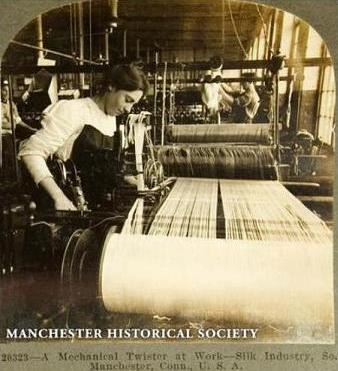



In this picture a mechanical twister is shown in operation. The machine is run by power and duplicates the motion of the human twister's thumb and fingers by running the threads together between two rubber pads. It then cuts off the loose ends with a knife. The mechanical twister is very quick and efficient, but is most suitable for threads from which the gum has not been boiled off.
When the operation of sleying is completed, that is, after the warp threads have been drawn through the harness, shown at the rear of the machine in this picture, and then through the reed or comb, the silk is ready for the loom. The warp with the harness and reed is now placed in the proper position in the loom. The warp beam is put at the back next to the harness and the reed is placed on the lathe or batten. Another beam is necessary on which the cloth may be rolled up. When the weaving is commenced a certain number of shafts of the harness are raised up. This lifts some of the warp threads above the others. The shuttle is now thrown through the space between them. The shuttle contains a bobbin or quill of thread which is unwound as it passes through, supplying the cross threads or filling. Then the lathe carrying the reed swings forward and pushes the filling into its proper place. This process is repeated with the different shafts lifted at such times as to produce the desired pattern or weave.
For pictures and contemporary information on the Spinning Mill or 'Clock Tower Mill' in the
"Cheney Brothers National Historic Landmark District" page, click here.

 )
)